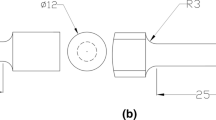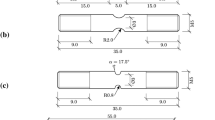Abstract
The quasi-static standard tensile, torsional, and combined tension and torsion tests were performed at room temperature to investigate the mechanical properties of normalized AISI 1045 steel specimens. The performance of yielding, Young’s modulus, and modulus of elasticity in shear were analyzed via two kinds of experiments with sequence-given loading paths, such as tension-torsion (torsional response after tension) and torsion-tension (tensile response after torsion) tests, under various preloads. Additionally, time-variant coupled effects between the shear stress and normal stress responded similarly in tension-torsion and torsion-tension experiments. Results demonstrate that ultimate strengths of torsion and tension obtained by combined tension and torsion tests were consistent with those strengths achieved by standard uniaxial tests. Yield strengths derived by the Von Mises criterion and combined tension and torsion test were compared, and results showed maximum deviations of 23.01% and 43.28% in shear and normal stress, respectively. Results indicated that the material exhibited quite different mechanical properties under combined loads of tension and torsion from those under uniaxial loads.

ᅟ





















Similar content being viewed by others
References
Guo JZ, Wang D, Fan R, Chen WY, Zhao GH (2016) Development of a material testing machine with multi-dimensional loading capability. J Adv Mech Des Syst 10. https://doi.org/10.1299/jamdsm.2016jamdsm0017
Li Y, Lu J (2014) Lightweight structure design for wind energy by integrating nanostructured materials. Mater Design 57:689–696. https://doi.org/10.1016/j.matdes.2013.11.082
Anderson KR, Clark A, Forgette D, Devost M, Okerson R, Wells T, Cunningham S, Stuart M (2014) Analysis and design of a lightweight high specific power two-stroke polygon engine. J Eng Gas Turbines Power 136:041508-1-041508-8. https://doi.org/10.1115/1.4026049
Feng B, Xu ML, Zhao TF, Zhang ZJ, Lu TJ (2010) Triaxial extensometer for volumetric strain measurement in a hydro-compression loading test for foam materials. Meas Sci Technol 21. https://doi.org/10.1088/0957-0233/21/11/115705
Yu MH (2002) Advances in strength theories for materials under complex stress state in the 20th Century. Mech Rev 55:169–218. https://doi.org/10.1115/1.1472455
De Souza Neto EA, Perić D, Owen DRJ (2008) Computational methods for plasticity: theory and applications. Oxford, New York. https://doi.org/10.1002/9780470694626
Wei QS (1995) Interaction yield hypersurfaces for the plastic behaviour of beams - II. Combining bending, tension, shear and torsion. Int J Mech Sci 37:221–238. https://doi.org/10.1016/0020-7403(95)93520-G
Barlat F, Ha J, Gracio JJ, Lee M-G, Rauch EF, Vincze G (2013) Extension of homogeneous anisotropic hardening model to cross-loading with latent effects. Int J Plast 46:130–142. https://doi.org/10.1016/j.ijplas.2012.07.002
Andrianopoulos NP, Manolopoulos VM (2014) Elastic strain energy density decomposition in failure of ductile materials under combined torsion-tension. IJMME 9:1–12. https://doi.org/10.1186/s40712-014-0016-5
Marciniak Z, Duncan JL, Hu SJ (2002) Mechanics of sheet metal forming. Butterworth-Heinemann, Oxford
Lee CS, Hwang W, Park HC, Han KS (1999) Failure of carbon/epoxy composite tubes under combined axial and torsional loading 1. Experimental results and prediction of biaxial strength by the use of neural networks. Compos Sci Technol 59:1779–1788. https://doi.org/10.1016/S0266-3538(99)00038-X
Khashaba UA, Aldousari SM, Najjar IMR (2012) Behavior of [0]8 woven composites under combined bending and tension loading: part - I experimental and analytical. J Compos Mater 46:1345–1355. https://doi.org/10.1177/0021998311418390
Khoshbakht M, Chowdhury SJ, Seif MA, Khashaba UA (2009) Failure of woven composites under combined tension-bending loading. Compos Struct 90:279–286. https://doi.org/10.1016/j.compstruct.2009.02.012
Palmer SO, Nettles AT, Poe CC (1999) An experimental study of a stitched composite with a notch subjected to combined bending and tension loading. NASA TM 1999–209511
Zheng XL, Zhao K, Wang H, Yan JH (2003) Failure criterion with given survivability for ceramic notched elements under combined tension/torsion. Mat Sci Eng A-Struct 357:196–202. https://doi.org/10.1016/S0921-5093(03)00161-8
Nohut S, Usbeck A, Oezcoban H, Krause D, Schneider GA (2010) Determination of the multiaxial failure criteria for alumina ceramics under tension-torsion test. J Eur Ceram Soc 30:3339–3349. https://doi.org/10.1016/j.jeurceramsoc.2010.08.008
Lee JW, Kim SN, Lee MG, Barlat F (2011) Evaluation of anisotropic yield functions characterized by uniaxial and biaxial experiments for formability of DP590 sheet steel. In: Menary G (ed) 14th international conference on material forming Esaform, 2011 proceedings, vol 1353. AIP conference proceedings. pp 1458-1463. https://doi.org/10.1063/1.3589722
Brünig M, Gerke S, Schmidt M (2016) Experiments on damage and failure mechanisms in ductile metals at different loading conditions. In: Naumenko K, Aßmus M (eds) Advanced methods of continuum mechanics for materials and structures. Springer Nature, Singapore, pp 279–293. https://doi.org/10.1007/978-981-10-0959-4_15
Kim S, Lee J, Barlat F, Lee MG (2013) Formability prediction of advanced high strength steels using constitutive models characterized by uniaxial and biaxial experiments. J Mater Process Technol 213:1929–1942. https://doi.org/10.1016/j.jmatprotec.2013.05.015
Bruschi S, Altan T, Banabic D, Bariani PF, Brosius A, Cao J, Ghiotti A, Khraisheh M, Merklein M, Tekkaya AE (2014) Testing and modelling of material behaviour and formability in sheet metal forming. Cirp Ann-Manuf Techn 63:727–749. https://doi.org/10.1016/j.cirp.2014.05.005
Graf A, Hosford W (1994) The influence of strain-path changes on forming limit diagrams of A1 6111 T4. Int J Mech Sci 36:897–910. https://doi.org/10.1016/0020-7403(94)90053-1
Wilson DV, Zandrahimi M, Roberts WT (1990) Effects of changes in strain path on work-hardening in CP aluminium and an Al Cu Mg alloy. Acta Mater 38:215–226. https://doi.org/10.1016/0956-7151(90)90051-H
Ha J, Lee MG, Barlat F (2013) Strain hardening response and modeling of EDDQ and DP780 steel sheet under non-linear strain path. Mech Mater 64:11–26. https://doi.org/10.1016/j.mechmat.2013.04.004
Andrusca L, Goanta V, Barsanescu PD, Savin A (2016) Experimental characterization of materials subjected to combined loading conditions. In: Doroftei I, Popescu A, Bujoreanu C (eds) 7th international conference on advanced concepts in mechanical engineering, vol 147. IOP Conference Series-Materials Science and Engineering. https://doi.org/10.1088/1757-899X/147/1/012092
Wang CP, Li FG, Wei L, Yang YJ, Dong JZ (2013) Experimental microindentation of pure copper subjected to severe plastic deformation by combined tension-torsion. Mat Sci Eng A-Struct 571:95–102. https://doi.org/10.1016/j.msea.2013.01.057
Li JH, Li FG, Hussain MZ, Wang CP, Wang L (2014) Micro-structural evolution subjected to combined tension-torsion deformation for pure copper. Mat Sci Eng A-Struct 610:181–187. https://doi.org/10.1016/j.msea.2014.04.083
Correa ECS, Aguilar MTP, Cetlin PR (2002) The effect of tension/torsion strain path changes on the work hardening of Cu-Zn brass. J Mater Process Technol 124:384–388. https://doi.org/10.1016/s0924-0136(02)00265-0
Correa ECS, Aguilar MTP, Monteiro WA, Cetlin PR (2000) Work hardening behavior of pre-strained steel in tensile and torsion tests. J Mater Sci Lett 19:779–781. https://doi.org/10.1023/a:1006768706054
Graham SM, Zhang TT, Gao XS, Hayden M (2012) Development of a combined tension-torsion experiment for calibration of ductile fracture models under conditions of low triaxiality. Int J Mech Sci 54:172–181. https://doi.org/10.1016/j.ijmecsci.2011.10.007
Millán MR, Romero AV, Arias Á (2015) Failure behavior of 2024-T3 aluminum under tension-torsion conditions. J Mech Sci Technol 29:4657–4663. https://doi.org/10.1007/s12206-015-1011-3
Korneva A, Korznikova G, Berent K, Korznikov A, Kashaev R, Bogucka J, Sztwiertnia K (2014) Microstructure evolution and magnetic properties of hard magnetic FeCr22Co15 alloy subjected to tension combined with torsion. J Alloys Compd 615:S300–S303. https://doi.org/10.1016/j.jallcom.2014.01.207
Timoshnko SP (1991) Mechanics of material. Springer Science, UK. https://doi.org/10.1007/978-1-4899-3124-5
Liu LH (2015) Material mechanics experimental tutorial. Posts & Telecom, Beijing
Richard GB (1999) Advanced strength and applied stress analysis. WCB/McGraw-Hill, Boston
Acknowledgements
All of the experiments described herein was performed at Beijing University of Technology and was supported by National Natural Science Foundation of China (51305013).
Author information
Authors and Affiliations
Corresponding author
Rights and permissions
About this article
Cite this article
Zhao, G., Liu, L., Wang, D. et al. Mechanical Properties of AISI 1045 Steel Subjected to Combined Loads of Tension and Torsion. Exp Tech 42, 393–406 (2018). https://doi.org/10.1007/s40799-018-0236-3
Received:
Accepted:
Published:
Issue Date:
DOI: https://doi.org/10.1007/s40799-018-0236-3




